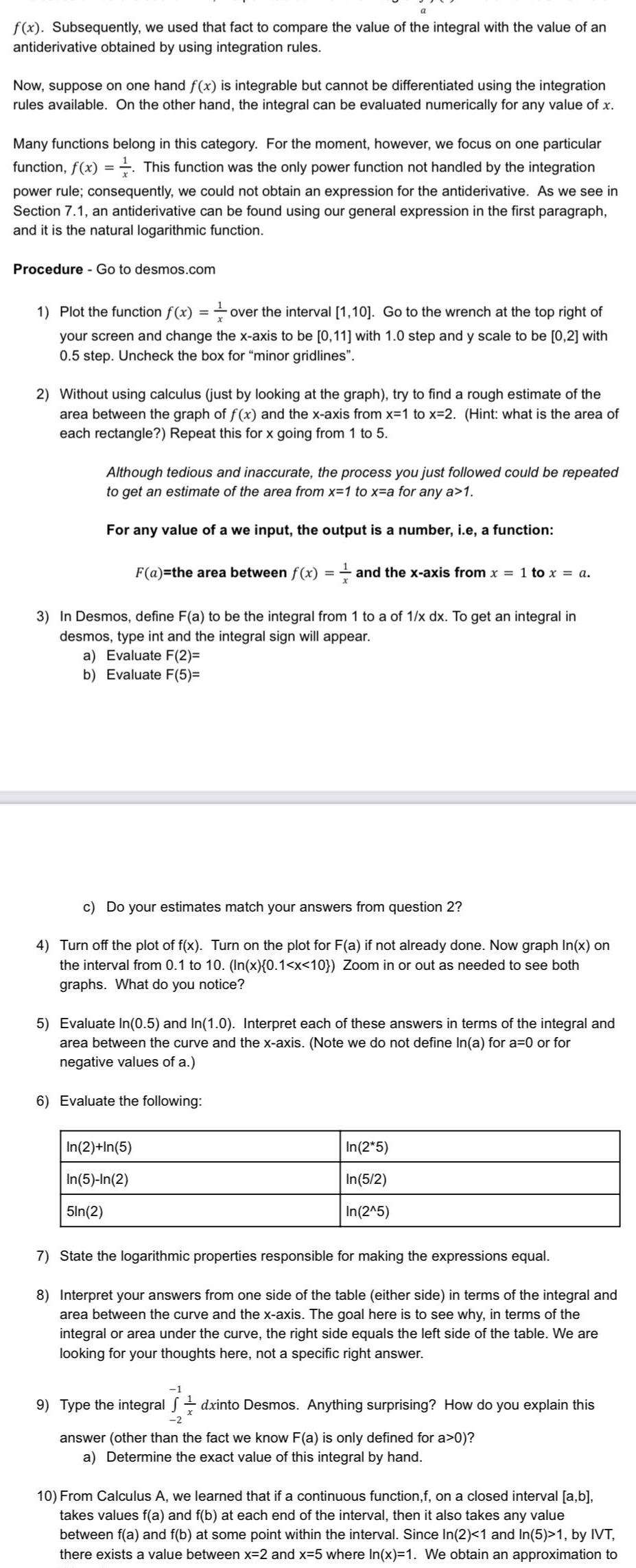a f x Subsequently we used that fact to compare the value of
Last updated: 9/8/2023

a f x Subsequently we used that fact to compare the value of the integral with the value of an antiderivative obtained by using integration rules Now suppose on one hand f x is integrable but cannot be differentiated using the integration rules available On the other hand the integral can be evaluated numerically for any value of x Many functions belong in this category For the moment however we focus on one particular function f x This function was the only power function not handled by the integration power rule consequently we could not obtain an expression for the antiderivative As we see in Section 7 1 an antiderivative can be found using our general expression in the first paragraph and it is the natural logarithmic function Procedure Go to desmos com 1 Plot the function f x over the interval 1 10 Go to the wrench at the top right of your screen and change the x axis to be 0 11 with 1 0 step and y scale to be 0 2 with 0 5 step Uncheck the box for minor gridlines 2 Without using calculus just by looking at the graph try to find a rough estimate of the area between the graph of f x and the x axis from x 1 to x 2 Hint what is the area of each rectangle Repeat this for x going from 1 to 5 Although tedious and inaccurate the process you just followed could be repeated to get an estimate of the area from x 1 to x a for any a 1 For any value of a we input the output is a number i e a function F a the area between f x and the x axis from x 1 to x a 3 In Desmos define F a to be the integral from 1 to a of 1 x dx To get an integral in desmos type int and the integral sign will appear a Evaluate F 2 b Evaluate F 5 c Do your estimates match your answers from question 2 4 Turn off the plot of f x Turn on the plot for F a if not already done Now graph In x on the interval from 0 1 to 10 In x 0 1 x 10 Zoom in or out as needed to see both graphs What do you notice 5 Evaluate In 0 5 and In 1 0 Interpret each of these answers in terms of the integral and area between the curve and the x axis Note we do not define In a for a 0 or for negative values of a 6 Evaluate the following In 2 In 5 In 5 In 2 5ln 2 In 2 5 In 5 2 In 2 5 7 State the logarithmic properties responsible for making the expressions equal 8 Interpret your answers from one side of the table either side in terms of the integral and area between the curve and the x axis The goal here is to see why in terms of the integral or area under the curve the right side equals the left side of the table We are looking for your thoughts here not a specific right answer 1 9 Type the integral dxinto Desmos Anything surprising How do you explain this 2 answer other than the fact we know F a is only defined for a 0 a Determine the exact value of this integral by hand 10 From Calculus A we learned that if a continuous function f on a closed interval a b takes values f a and f b at each end of the interval then it also takes any value between f a and f b at some point within the interval Since In 2 1 and In 5 1 by IVT there exists a value between x 2 and x 5 where In x 1 We obtain an approximation to